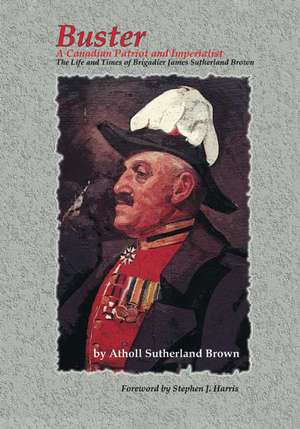Buster
Autor Atholl Sutherland Brownen Limba Engleză Paperback
As District Officer Commanding in Victoria during the Great Depression he managed on a slim budget to get military facilities built and the Militia as prepared as possible in anticipation of WWII. He then lost a confrontation with his immediate superior, General McNaughton, centred on the humane treatment of the unemployed in Relief Camps in the 1930s and consequently he resigned. Though he sought one, he was refused a role in WWII as a result of this clash.
Preț: 147.50 lei
Nou
28.23€ • 29.16$ • 23.49£
Carte disponibilă
Livrare economică 04-18 martie
Specificații
ISBN-10: 1412025222
Pagini: 242
Dimensiuni: 178 x 254 x 13 mm
Greutate: 0.43 kg
Editura: Troubador Publishing
Notă biografică
Atholl Sutherland Brown was born in Ottawa in 1923, the third son of James and Clare Sutherland Brown. He lived in London for a year as a child but grew up and lived much of his life in Victoria, Canada. He was a pilot in Burma with 177 Beaufighter Squadron in 1944-1945 and was awarded the DFC in 1945, after the war he became a geologist with a PhD from Princeton University. He was a research geologist with the BC Geological Survey and its chief geologist for ten years. Table of Contents and Excerpts
Jame did not know it at the time but this was his farewell to the Regiment. Although he disguised it well he was quite an emotional man. All his service career, and afterwards until his death, he bore a great love for the Regiment, his brother officers and the troops from his batman, Pte. Quick to the Regimental Sergeant Major. Little things like his tattoo of the regimental crest on his forearm exhibited his attachment. Whether this was drawn following high jinks after a mess party or in sober circumstances hardly matters. More importantly, his affection was shown in July 1928 when he was struck off strength of the Regiment after having been a member of it or nominally of its reinforcement satellite, the Nova Scotia Regiment, ever since he left in 1913. His letter in 1928 to Lt. Col. E.A. Seely Smith, the current CO states: "I have just received the Gazette, with mixed feelings, [noting] I have been struck off strength of the old Regiment... on promotion to Colonel... . I assure you my heart, my thoughts and my efforts have always been with the Regiment. Not only with the serving [personnel] but also with the vast number of my ex-members whom I have constantly come into contact... personally or by letter... . I hope the [authorities] will continue to show me in the list of old soldiers entitled: 'Removed from the Regiment and still on the active list.' I assure you, the officers and men of the Regiment that wherever I am; my best wishes will be with you all and any small influence I have will always be at the command of the Regiment as also will be my best endeavours to advance its course... . I visited with pleasure and interest the depot of the Gloucestershire Regiment [an affiliated regiment] at Bristol last January and intend the Territorial Battalions in competition next month. Kindest regards [to all]."21 This letter was circulated to all ranks in the Regiment and Seely Smith responded to James that "all members of the Regiment are heartily sorry to see your name taken off the Regiment list."
The Advance to Mons and the March to the Rhine
The 1st Division then went into rest and reserve until 12 October. When the Division again entered the fray it was slightly north of where it finished, positioning itself for advance from Douai to Mons, the important Belgian coal and industrial town. In retreat the Germans laid waste to the Belgian countryside, stripping it of all farm animals and destroying all the bridges, canal lock and flooding the country. Even so their retreat was rapid, and it was difficult for the Canadians to keep in contact with them. Supply under such circumstances was the major problem. As Currie said of this: "Because the advances were so substantial, [the] enormous logistical demand was hard to anticipate and supplies and replacements had to be moved further and faster to be at the right place at the right time."29
Division headquarters moved daily. Although this and the supply problems became routine it still involved Buster and his men in a lot of work which was carried out very ef













